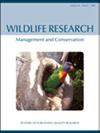Spatial and temporal variation in the diet of introduced sambar deer (Cervus unicolor) in an alpine landscape
IF 1.6
3区 生物学
Q3 ECOLOGY
引用次数: 0
Abstract
Context In south-eastern Australia, the abundance and distribution of non-native sambar deer (Cervus unicolor) has increased dramatically in alpine environments. As a result, significant concern surrounds the potential for the species to impact rare plant species and vegetation communities through browsing.Aims We aimed to determine the diversity of the plant species eaten by sambar deer in the Alpine National Park and to understand any spatial and temporal variation in deer diets.Methods We collected 90 sambar deer faecal pellet samples over a 3-month flowering period across two contrasting study sites with differing elevation, vegetation and underlying geology. We performed DNA sequencing using the ITS2 gene region and assigned dietary items to the lowest taxonomic level possible. The frequency of occurrence and sequencing read depth of each dietary item was calculated to investigate the diet of sambar deer at spatial and temporal scales, and dietary preferencing was assessed by comparing the frequency of occurrence of dietary items to the observation records for each dietary item in the study area.Key results We detected a total of 369 unique plant Operational Taxonomic Units (OTUs) from sambar deer faecal samples, representing 35 families and 80 genera. Considerable variation in the diet was observed over small spatial scales, and evidence of temporal diet variation was noted in one of the study sites. We detected Silky Snow-daisy (Celmisia sericophylla), which is currently listed as critically endangered under the Victorian Flora and Fauna Guarantee Act 1988, and Hawkweed (Pilosella spp.), a highly invasive, non-native taxon that is sparingly established in Alpine ecosystems.Conclusions Sambar deer displayed an intermediate feeder behaviour in alpine environments, foraging on a variety of forbs and shrubs, but forbs were the dominant dietary items. The spatial variation observed in the diet of sambar deer suggests that individual deer are unlikely to be dispersing widely while foraging.Implications Our results emphasise the need for careful evaluation of sambar deer impacts within individual sites and at small spatial scales. The detection of species of conservation significance in the diet indicates that the presence of sambar deer should be considered a significant risk to biodiversity in areas of high conservation value.高山地区引进山巴鹿(Cervus unicolor)饮食的时空变化
在澳大利亚东南部的高山环境中,非本地桑巴鹿(Cervus unicolor)的丰度和分布急剧增加。因此,人们非常关注该物种对稀有植物物种和植被群落的潜在影响。本研究旨在确定阿尔卑斯国家公园山巴尔鹿食用的植物种类的多样性,并了解鹿饮食的时空变化。方法在两个不同海拔、植被和地质条件的研究地点,收集了90个花期3个月的鹿粪颗粒样本。我们使用ITS2基因区域进行DNA测序,并将饮食项目分配到尽可能低的分类水平。计算各食材的出现频率和序列读取深度,从空间和时间尺度上考察各食材的出现频率,并将各食材的出现频率与研究区各食材的观测记录进行比较,评价其对食材的偏好。主要结果从鹿粪便中共检测到369个独特的植物操作分类单位(OTUs),分别属于35科80属。在小的空间尺度上观察到饮食的相当大的变化,并且在一个研究地点发现了饮食时间变化的证据。我们发现了丝雪菊(Celmisia sericophylla),它目前被列入1988年维多利亚动植物保障法的极度濒危物种,以及山楂(Pilosella spp.),这是一种高度入侵的非本地分类群,在高山生态系统中很少建立。结论山鹿在高山环境中表现为中间摄食行为,以多种牧草和灌木为食,但以牧草为主要食材。观察到的斑马鹿饮食的空间差异表明,个体鹿不太可能在觅食时广泛分散。我们的研究结果强调了在单个地点和小空间尺度上仔细评估沙鹿影响的必要性。在饮食中检测到具有保护意义的物种表明,在具有高保护价值的地区,应将麋鹿的存在视为对生物多样性的重大威胁。
本文章由计算机程序翻译,如有差异,请以英文原文为准。
求助全文
约1分钟内获得全文
求助全文
来源期刊

Wildlife Research
生物-动物学
CiteScore
4.30
自引率
15.80%
发文量
56
审稿时长
3 months
期刊介绍:
Wildlife Research represents an international forum for the publication of research and debate on the ecology, management and conservation of wild animals in natural and modified habitats. The journal combines basic research in wildlife ecology with advances in science-based management practice. Subject areas include: applied ecology; conservation biology; ecosystem management; management of over-abundant, pest and invasive species; global change and wildlife management; diseases and their impacts on wildlife populations; human dimensions of management and conservation; assessing management outcomes; and the implications of wildlife research for policy development. Readers can expect a range of papers covering well-structured field studies, manipulative experiments, and analytical and modelling studies. All articles aim to improve the practice of wildlife management and contribute conceptual advances to our knowledge and understanding of wildlife ecology.
Wildlife Research is a vital resource for wildlife scientists, students and managers, applied ecologists, conservation biologists, environmental consultants and NGOs and government policy advisors.
Wildlife Research is published with the endorsement of the Commonwealth Scientific and Industrial Research Organisation (CSIRO) and the Australian Academy of Science.
 求助内容:
求助内容: 应助结果提醒方式:
应助结果提醒方式:


